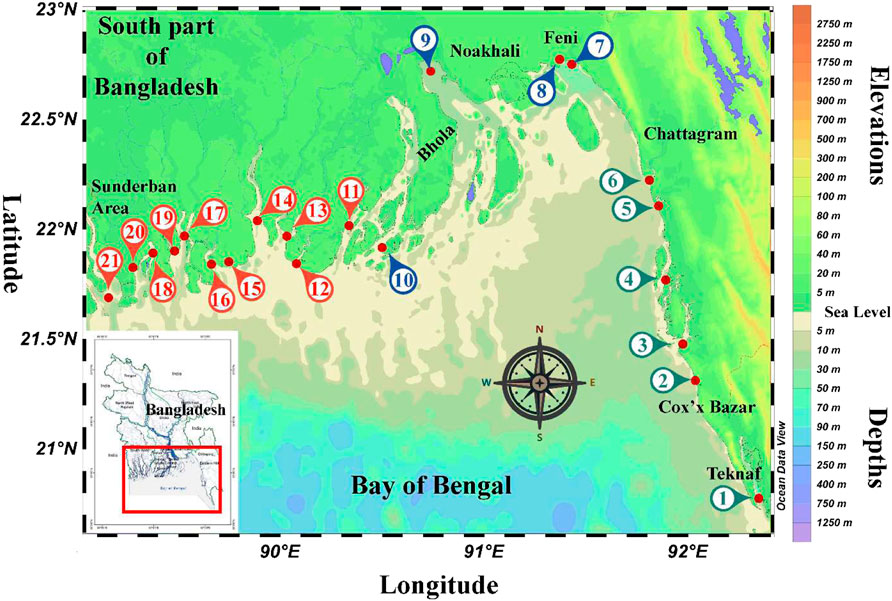Estuaries
Estuary, a transition point between fresh and salt water, is the world’s most diverse, dynamic, and productive ecosystem. Estuary combines unique physical, chemical, biological, and geological features. As per a recent estimate, estuaries are four times more productive than ryegrass pastures and 20-times more productive than the open sea, with production occurring through active photosynthesis both throughout the water column and on the sediment surface (Boicourt et al., 2012). Reasons for such high productivity in estuaries include shallow waters, lots of sun exposure and land runoff containing nitrogen, phosphorus and silica (Jaksha, 2013). The estuarine organisms use productive ecosystems such as seagrass communities, oyster beds, mudflats, mangrove forests and salt marshes for spawning, feeding, nursing, and migration.
The coastline of Bangladesh stretches across 710 km of the Bay of Bengal and contains several river-based estuaries along their tidal zones. The margins of estuaries support important primary producers, e.g., algae, seagrass, and mangroves, which provide large quantities of organic matter. Thus, in addition to high productivity, estuaries are extremely rich in organic matter and nutrients, transported and trapped through freshwater flow, wind, waves, and tidal action (Rakib et al., 2022). As a result of productivity and high nutrient loads, many species of fish and shellfish use estuaries as nursery grounds to spawn and allow juveniles to grow. Additionally, many birds, mammals, fish, and other wildlife depend on estuaries to complete their life cycle (Rakib et al., 2022).

Figure: Location of the major estuaries in Bangladesh coast (Rakib et al., 2022). 1: Naf River Estuary; 2: Rezu Cannal Estuary; 3: Bakkhali River Estuary; 4: Matamuhuri River Estuary; 5: Sangu River Estuary; 6: Karnaphuly River Estuary; 7: Feni River Estuary; 8: Choto Feni River Estuary; 9: Meghna River Estuary; 10: Tetulia River Estuary; 11: Galacipa River Estuary; 12: Andharmanik River Estuary; 13: Payra River Estuary; 14: Balaswar River Estuary; 15: Betmore River Estuary; 16: Sela River Estuary; 17: Pussur River Estuary; 18: Arpangachia River Estuary; 19: Sundarban River Estuary; 20: Malanchi River Estuary; 21: Ichamoti River Estuary.
Reference:
Boicourt WC, Li M, Nidzieko N, Blumberg AF, Georgas N and Kelly EJ (2012). Observing the urban estuary: Review and prospect. In: Proceeding of the 2012 Oceans, Hampton Roads, VA, USA, 1–9.
Rakib MRJ, Hossain MB, Islam MS, Hossain I, Rahman MM, Kumar R and Sharma P (2022) Ecohydrological features and biodiversity status of estuaries in Bengal delta, Bangladesh: A comprehensive review. Frontiers in Environmental Science. https://doi.org/10.3389/fenvs.2022.990099
Jaksha AP (2013) Biodiversity in the Ocean. In: Fisher RJ, Hirsh ET, Jaksha AP, Matz MS, Marrero ME, Richardson LJ and Treiber TG (eds.), One Ocean, 42-63 pp. https://education.nationalgeographic.org/resource/one-ocean-teacher-guide/